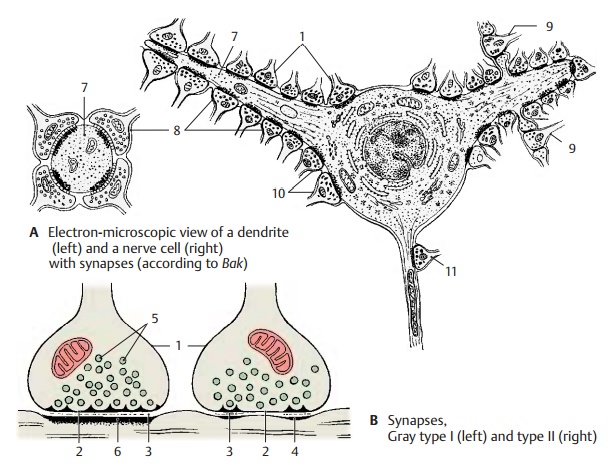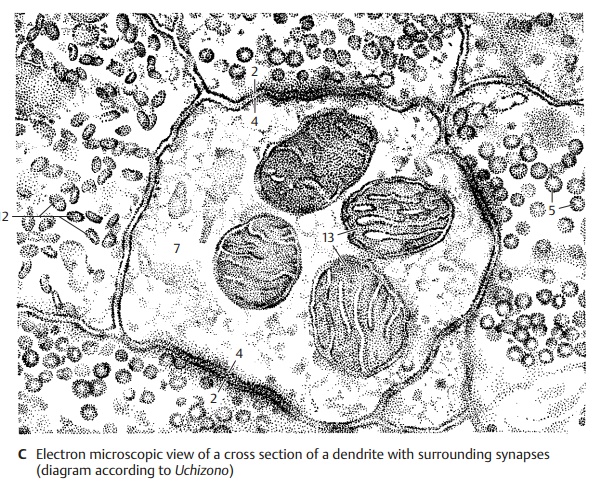Chapter: Human Nervous System and Sensory Organs : Basic Elements of the Nervous System
The Synapse: Localization, Structure, Function
The Synapse
The axon ends with numerous small knob-like swellings, the axon terminals or boutons. Together with the apposed membrane of the next neuron, the bouton forms the syn-apse where excitation is transmitted fromone neuron to another.
The synapse consists of the presynaptic com-ponent (bouton) (AB1) with thepresynapticmembrane (BC2), the synaptic cleft (B3), andthepostsynaptic component with the postsyn-aptic membrane (BC4) of the next neuron.The bouton is free of neurofilaments and neurotubules but contains mitochondria and small, mainly clearvesicles (BC5) which are clustered near the presynaptic mem-brane (active zone). The synaptic cleft con-tains filamentous material and communi-cates with the extracellular space. The pre-synaptic and postsynaptic membranes ex-hibit dense zones of apposition, which re-semble those found at various cell junctions (zonulae or maculae adherentes, adherent junctions or desmosomes). In asymmetric synapses (see below), the density of the postsynaptic membrane (B6) is more prom-inent than the presynaptic density.
Synapses can be classified according to their localization, their structure, and their func-tion, or according to the neurotransmitter substances they contain.
Localization (A)
The boutons may be apposed to dendrites (AC7) of the receptor neuron (axodendriticsynapses) (A8, C), to small projections of thedendritic membrane, spines (axospinous syn-apses) (A9), to the perikaryon (axosomatic synapses) (A10), or to the initial segment ofthe axon (axoaxonal synapses) (A11). Large neurons are occupied by thousands of bou-tons.

Structure (B)
Depending on the width of the synaptic cleft and the properties of the apposing membranes, two types of synapses, type Iand type II, can be distinguished according to Gray. In type I synapses, the synaptic cleft is wider and the density of the postsynaptic membrane is more pronounced (asymmetricsynapse). Intype II synapses, the synapticcleft is narrower and the postsynaptic den-sity is about the same as the presynaptic density (symmetric synapse).
Function (C)
There are excitatory and inhibitory synapses. The majority of the excitatory synapses are found at the dendrites, often at the heads of the spines (A9). Most of the inhibitory syn-apses are found at the perikaryon or at the axon hillock, where excitation is generated and can be most effectively suppressed. While synaptic vesicles are usually round, some boutons contain oval or elongated vesicles (C12). They are characteristic of in-hibitory synapses. Asymmetric synapses(type I) are often excitatory, whereas sym-metric synapses (type II) are mostly inhibi-tory.
C13 Mitochondria.

Related Topics